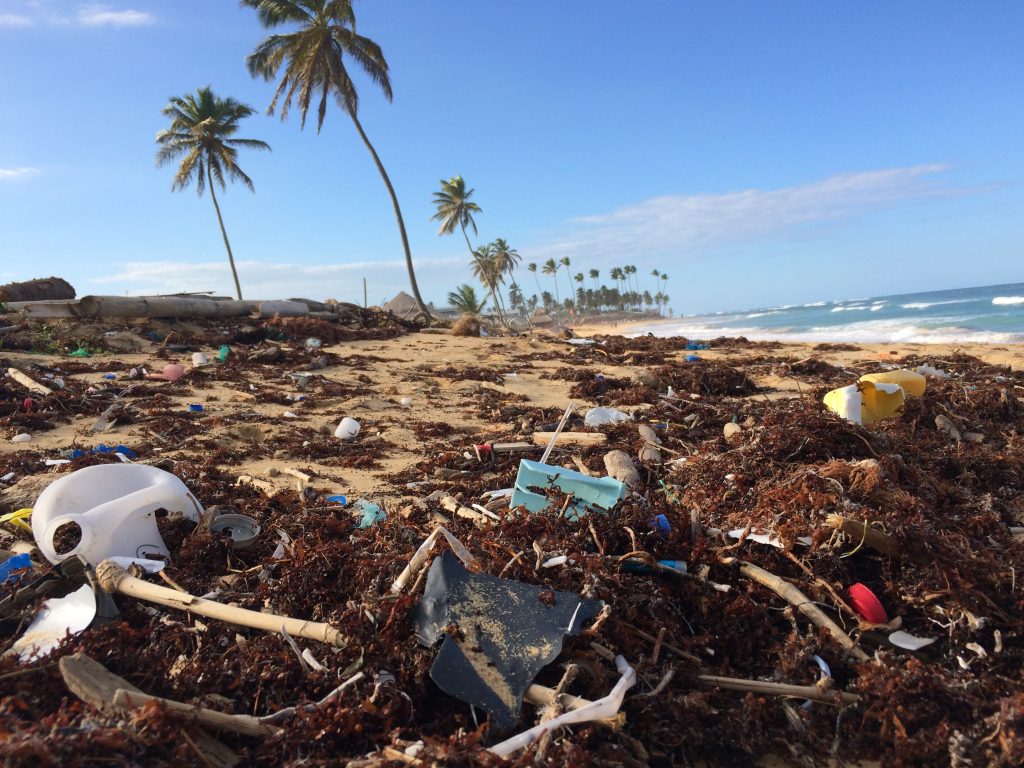เป้าหมายการพัฒนาที่ยั่งยืนที่ 14 มีเป้าหมายเพื่อ “อนุรักษ์และใช้ประโยชน์จากมหาสมุทรและทรัพยากรทางทะเล เพื่อการพัฒนาอย่างยั่งยืน” ซึ่งเป็นเป้าหมายที่สำคัญต่อประเทศ เช่น ประเทศไทยที่มีพรมแดนติดกับ 2 มหาสมุทร ได้แก่ มหาสมุทรแปซิฟิกและมหาสมุทรอินเดีย1 ความก้าวหน้าเกี่ยวกับเป้าหมายการพัฒนาอย่างยั่งยืนที่ 14 ที่กำลังถูกวัดเทียบกับเป้าหมายและตัวชี้วัดที่เกี่ยวข้อง ซึ่งสามารถศึกษาได้จากข้อมูลบนเว็บไซต์ ODM ซึ่งจะต้องมีเพื่อให้ประเทศไทยประสบความสำเร็จในการบรรลุเป้าหมายการพัฒนาอย่างยั่งยืน
เป้าหมายดังกล่าวได้รับการพัฒนาโดยกลุ่มผู้เชี่ยวชาญและหน่วยงานต่างๆ ระหว่างประเทศ เกี่ยวกับตัวชี้วัดการพัฒนาอย่างยั่งยืน (กลุ่มสิ่งแวดล้อมด้านอวกาศระหว่างประเทศ-เป้าหมายการพัฒนาอย่างยั่งยืน) และได้รับความเห็นชอบจากประชาคมระหว่างประเทศเมื่อเดือนมีนาคม พ.ศ. 25592 เป้าหมายและตัวชี้วัดต่างๆ สำหรับเป้าหมายการพัฒนาอย่างยั่งยืน SDG 14 นี้ ครอบคลุมประเด็นต่างๆ ที่เกี่ยวกับมหาสมุทร ทะเลและทรัพยากรทางทะเล และมีความพยายามที่จะนำไปสู่การพัฒนาอย่างยั่งยืนของทรัพยากรทางทะเลในวงกว้างทั้งในประเทศไทยและทั่วโลก เป้าหมายบางอย่าง เช่น ตัวชี้วัดที่ 14.1 ที่มุ่งเน้นลดมลภาวะทางทะเล เช่น พลาสติก กำลังได้รับความสำคัญอย่างสูงในวาระทางการเมืองแล้ว3 เมื่อเร็วๆ นี้พลาสติกได้กลายเป็นกระแสข่าวทั่วประเทศ หลังจากปลาวาฬตัวแรกเสียชีวิตและลอยมาขึ้นชายหาดในพื้นที่ภาคใต้ของประเทศไทยเนื่องจากกินถุงพลาสติกจำนวนมาก และได้นำไปสู่การประท้วงเกี่ยวกับมลภาวะจากพลาสติก ตัวชี้วัดอื่นๆ ค่อนข้างเป็นวิชาการและอยู่ในความสนใจเพียงเล็กน้อยของสาธารณะ เช่น ตัวชี้วัดที่ 14.6 ซึ่งมองไปถึงการห้ามอุดหนุนสินค้าและกิจกรรมบางประเภท อย่างไรก็ตามตัวชี้วัดทั้งหมดจะต้องบรรลุ หากประเทศไทยมีความพยายามให้เป้าหมายการพัฒนาอย่างยั่งยืนที่ 14 ประสบความสำเร็จ
ประเทศไทยมีหลายเหตุผลที่จะลงทุนในมหาสมุทรและสภาพแวดล้อมทางทะเลของตนเอง มีชายฝั่งทะเลมากกว่า 3,148 กิโลเมตร ซึ่งครอบคลุมจำนวน 23 จังหวัด4 สภาพแวดล้อมทางทะเลเหล่านี้มีความหลากหลายทางชีวภาพและเป็นที่อยู่ของปลาสายพันธุ์ต่างๆ ในโลกมากกว่าร้อยละ 25 5 เศรษฐกิจของประเทศมีความเชื่อมโยงกับสภาพแวดล้อมทางทะเลโดยพื้นที่ชายฝั่งมีบทบาทสำคัญในการพัฒนาเศรษฐกิจของประเทศไทย โดยเฉพาะอย่างยิ่งการท่องเที่ยว ซึ่งขึ้นอยู่กับการจัดการพื้นที่ชายฝั่งทะเลอย่างยั่งยืน โดยนักท่องเที่ยวย่อมต้องการสัตว์ป่าจำนวนมากและชายหาดที่สะอาดระหว่างการเที่ยวชมในประเทศ นอกจากนี้ อุตสาหกรรมน้ำมันและก๊าซ อุตสาหกรรมประมงและอาหารทะเลซึ่งถือว่าเป็น 1 ในอุตสาหกรรมที่มีขนาดใหญ่ที่สุดของโลก ตั้งอยู่ในภูมิภาคชายฝั่งทะเลนี้6
“หากเราไม่ดูแลและเผชิญหน้ากับการคุกคามต่างๆเหล่านี้ เราจะเผชิญกับวิกฤติที่เพิ่มขึ้นในอนาคตอันใกล้”
เจฟฟรีย์ ดี. แซคส์ ผู้อำนวยการสถาบันโลก กล่าวถึงภัยคุกคามที่มหาสมุทรของโลกกำลังเผชิญอยู่
บริบทในปัจจุบัน
การจัดการที่ยั่งยืนของพื้นที่ชายฝั่งทะเลของประเทศไทยต้องเผชิญกับความท้าทายมากมาย แนวปฏิบัติต่างๆ ของการทำประมงที่ไม่ยั่งยืนเป็นด้านหนึ่งซึ่งจำเป็นต้องดำเนินการให้มีความก้าวหน้าอย่างมีนัยสำคัญ เนื่องจากการลากอวนถึงระดับพื้นทะเล การทำการประมงที่ผิดกฎหมาย ขาดการรายงานและไร้การควบคุม (IUU – llegal, unregulated and unreported fishing) ได้ทำลายแหล่งทรัพยากรปลาและสิ่งแวดล้อมทางทะเลของไทยอย่างรุนแรง การทำการประมงที่ผิดกฎหมาย ไม่เป็นระเบียบและไม่มีการรายงานเป็นหนึ่งในภัยคุกคามที่สำคัญมากทั่วโลกต่อสภาพแวดล้อมทางทะเล เนื่องจากการปฏิบัติดังกล่าวไม่มีการตรวจสอบปริมาณสำรองของปลาและสัตว์ป่าที่มีประสิทธิภาพ ทำให้การจัดการประมงอย่างมีประสิทธิภาพทำได้ยากมากขึ้น7 เป็นที่รู้กันว่า ผู้ทำประมงที่ผิดกฎหมาย ขาดการรายงานและไร้การควบคุมมักใช้เทคนิคการประมงที่ไม่ยั่งยืน เช่น การลากอวนถึงระดับพื้นทะเล ซึ่งก่อให้เกิดความเสียหายอย่างถาวรต่อระบบนิเวศทางทะเล และบ่อยครั้งที่ส่งผลกระทบในระยะยาว หรือในบางครั้งไม่สามารถแก้ไขให้กลับเหมือนเดิมได้ หรือส่งผลกระทบทางลบหลายประการ แนวปะการังหลายแห่งของไทยได้รับผลกระทบอย่างมาก ส่งผลให้พื้นที่แนวปะการังลดลงอย่างมาก8
ประเทศไทยได้พยายามลดการทำประมงที่ผิดกฏหมาย ขาดการรายงานและไร้การควบคุมในช่วงไม่กี่ปีที่ผ่านมาซึ่งดูเหมือนว่าประสบความสำเร็จบางประการ9 เมื่อปี 2558 คณะกรรมาธิการยุโรปได้ให้ “ใบเหลือง” แก่ประเทศไทยเนื่องจากมีข้อสังเกตว่าขาดความพยายามในการแก้ไขปัญหาการทำประมงที่ผิดกฎหมาย ขาดการรายงานและไร้การควบคุม แต่ก็ได้เห็นการปรับปรุงในหลายด้านเพื่อจัดการกับปัญหาดังกล่าว ถึงแม้ประเทศไทยยังไม่ได้รับ “ใบเขียว” จากคณะกรรมาธิการยุโรป ทั้งคณะกรรมาธิการยุโรปและเจ้าหน้าที่ที่รับผิดชอบของประเทศไทยได้เปิดเผยว่า ประเทศไทยได้มีการดำเนินการและมีความก้าวหน้าอย่างมากในการลดการทำประมงที่ผิดกฎหมาย ไม่เป็นระเบียบและไม่มีการรายงานตั้งแต่การได้รับใบเหลืองในปี พ.ศ. 2558
ที่มา: สถิติการประมงและการเพาะเลี้ยงสัตว์น้ำประเทศไทย ขององค์การอาหารและเกษตรแห่งสหประชาชาติ ประเทศไทย. สร้างโดย ODM. กรกฎาคม 2561. สัญญาอนุญาต CC-BY-SA-4.0.
การทุจริตเป็นข้อกังวลหลักและเป็นปัจจัยหนึ่งที่ทำให้เกิดการทำประมงที่ผิดกฎหมาย ขาดการรายงานและไร้การควบคุมยังคงเกิดขึ้นอย่างต่อเนื่อง นอกจากนี้ สินค้าสัตว์ป่าที่ผิดกฎหมายซึ่งส่วนใหญ่มาจากสภาพแวดล้อมทางทะเลของประเทศไทย (เช่น กระเพาะปลา ครีบปลาฉลามบางประเภท หอยเป๋าฮื้อ และแตงกวาทะเล) ยังมีจำหน่ายและลักลอบค้าจากประเทศไทย ซึ่งในบางกรณีเป็นการปฏิบัติหน้าที่โดยทุจริตของเจ้าหน้าที่บังคับใช้กฎหมาย10 การจัดการประมงทำได้ยากขึ้นเนื่องจากการทุจริตที่ขัดขวางความพยายามในการปรับปรุงทั้งด้านแรงงานในอุตสาหกรรม และการติดตามตรวจสอบกิจกรรมการประมงต่างๆ ให้ถูกต้องตามกฎหมาย
พลาสติกและขยะในรูปแบบอื่นๆ ที่ไหลลงสู่ทะเลเป็นอีกหนึ่งความท้าทายที่สำคัญ ประเทศไทยถูกจัดให้อยู่อันดับ 5 หรืออันดับ 6 ของประเทศที่มีส่วนร่วมก่อให้เกิดขยะพลาสติกในมหาสมุทรมากที่สุดของโลก (ตามแหล่งข่าวที่แตกต่างกัน) ซึ่งถือว่าเป็นสัดส่วนที่สูงมากเมื่อเทียบกับขนาดของประเทศและระดับของการพัฒนาของประเทศ11, 12 ในแต่ละปี ประเทศไทยมีจำนวนขยะพลาสติกมากกว่า 1.03 ล้านตัน และร้อยละ 3 จากจำนวนนี้ไหลสู่มหาสมุทร คนที่อาศัยอยู่ในประเทศไทยใช้ถุงพลาสติกโดยเฉลี่ยจำนวน 8 ใบต่อวันต่อคน ส่วนใหญ่มาจากการใช้ถุงพลาสติกบรรจุอาหารที่จำหน่ายในร้านสะดวกซื้อและซูเปอร์มาร์เก็ตในประเทศไทย รวมทั้งผู้จำหน่ายอาหารริมถนนในไทยมักใช้ถุงพลาสติกอย่างแพร่หลายและเป็นจำนวนหลายถุงต่อมื้อที่ให้บริการลูกค้า

ชายหาดที่เต็มไปด้วยขยะพลาสติก. ภาพโดย ดาสตัน วู๊ดเฮาส์ จากเว็บไซต์ Unsplash
อุตสาหกรรมตามแนวชายฝั่งของไทยยังเป็นภัยคุกคามพื้นที่ทางทะเล เห็นได้จากรายงานน้ำเสียที่ไม่ผ่านการบำบัดและสารเคมีระบายลงสู่ทะเลจำนวนมาก ถึงแม้จะมีกฎหมายภาครัฐห้ามการปฏิบัติดังกล่าวก็ตาม13 ตั้งแต่ปี พ.ศ. 2547 มีการรั่วไหลของน้ำมันมากกว่า 12 ครั้ง ผลกระทบจากการรั่วไหลของน้ำมันในระยะยาวยังคงไม่ชัดเจน แต่การรั่วไหลเหล่านี้ส่งผลกระทบต่อการท่องเที่ยวทันที ทำให้นักท่องเที่ยวไม่มาท่องเที่ยวยังพื้นที่ชายหาดและชายฝั่งทะเลของประเทศไทยและสร้างความเสียหายต่อธุรกิจท้องถิ่นหลายแห่ง ตัวอย่างการรั่วไหลของน้ำมันเมื่อ พ.ศ. 2556 มีผลกระทบ “อย่างมาก” ต่อการท่องเที่ยว เนื่องจากน้ำมันดิบจำนวน 50,000 ลิตร ได้ไหลปกคลุมน่านน้ำโดยรอบของเกาะเสม็ด14
ผลกระทบจากการเปลี่ยนแปลงสภาพภูมิอากาศเป็นที่ชัดเจนแล้วในประเทศไทย และกำลังมีผลกระทบอย่างรุนแรงต่อสภาพแวดล้อมทางทะเล มหาสมุทรที่เป็นกรดมากขึ้นทำให้เกิดปรากฎการณ์ปะการังฟอกขาวในแนวปะการังหลายแห่งของประเทศไทย15 มหาสมุทรดูดซับคาร์บอนไดออกไซด์ประมาณร้อยละ 30 ของคาร์บอนไดออกไซด์ที่มนุษย์ผลิตขึ้นนับตั้งแต่เริ่มการปฏิวัติอุตสาหกรรม ซึ่งส่งผลให้กรดในมหาสมุทรเพิ่มขึ้นถึงร้อยละ 26 และเกิดความเสียหายอย่างมากต่อแนวปะการังของไทย16
อุตสาหกรรมการท่องเที่ยวยังส่งผลกระทบสำคัญต่อแนวปะการังและระบบนิเวศทางทะเลของไทย รายงานล่าสุดจากมหาวิทยาลัยเกษตรศาสตร์พบว่า แนวปะการังเสียหายเพิ่มจากร้อยละ 30 เป็นร้อยละ 77 ในช่วงทศวรรษที่ผ่านมา โดยมีสาเหตุหลักมาจากมลพิษจากอุตสาหกรรมการท่องเที่ยว17 ผลจากการศึกษาพบว่าโรงแรม รีสอร์ท และบ้านริมหาดจะสร้างมลพิษในบริเวณที่ตั้งริมน้ำ ซึ่งมักจะเป็นที่อยู่ของปะการังทำให้เกิดความเสียหายอย่างมาก มลพิษของขยะพลาสติกและหลุมฝังกลบที่ตั้งอยู่ใกล้กับชายฝั่งเป็นสาเหตุของการเสื่อมโทรมของสิ่งแวดล้อม ตัวอย่างเช่น แหล่งท่องเที่ยวที่สำคัญแห่งหนึ่งของไทย คือ อ่าวมาหยา ก็ต้องปิดรับนักท่องเที่ยวหลังจากกลายเป็น “แหล่งรับของเสีย” เนื่องจากสภาพแวดล้อมได้รับความเสียหายอย่างหนักจากการส่งเสริมการท่องเที่ยว18 กำหนดปิดหาดเป็นเวลา 4 เดือนด้วยความหวังว่า ชายหาดที่ตั้งอยู่ภายในหาดนพรัตน์ธารา อุทยานแห่งชาติหมู่เกาะพีพีจะมีระบบนิเวศที่ “ฟื้นตัว” หลังจากนั้น
ความก้าวหน้าในการดำเนินการตามเป้าหมายการพัฒนาอย่างยั่งยืนที่ 14
รัฐบาลไทยมีความพยายามที่จะปกป้องสภาพแวดล้อมทางทะเล และสร้างความก้าวหน้าในการลดความเสียหายด้านสิ่งแวดล้อมของพื้นที่ทางทะเลขณะที่ทรัพยากรทางทะเลและชายฝั่งยังคงอยู่ในสภาพเสื่อมโทรม19 ความก้าวหน้าประการหนึ่ง คือ พื้นที่ป่าชายเลนเพิ่มขึ้นจาก 2,333 ตารางกิโลเมตรในปี 2547 เป็น 2,445 ตารางกิโลเมตรในปี 2557 ถึงแม้ว่าจะปริมาณเล็กน้อย แต่ก็สังเกตได้ว่าเพิ่มขึ้น
รัฐบาลไทยยอมรับความรุนแรงของปัญหาพื้นที่ชายฝั่งทะเลที่กำลังเผชิญอยู่ ในการตอบสนองกับปัญหาดังกล่าว รัฐบาลไทยได้ออกพระราชบัญญัติส่งเสริมการบริหารจัดการทรัพยากรทางทะเลและชายฝั่ง พ.ศ. 2558 ซึ่งเป็นครั้งแรกที่ประเทศไทยมีการบังคับใช้กฎหมายที่เกี่ยวข้องกับความยั่งยืนทางทะเล กฎหมายดังกล่าวได้จัดตั้งคณะกรรมการแห่งชาติด้านการจัดการทรัพยากรทางทะเลและชายฝั่ง ซึ่งมีหน้าที่ความรับผิดชอบ ดังนี้
- จัดทำแผนและข้อเสนอแนะด้านนโยบายในการจัดการทรัพยากรทางทะเลและชายฝั่ง และติดตามการดำเนินงานของหน่วยงานที่เกี่ยวข้อง
- พิจารณาและอนุมัติพื้นที่ที่ต้องมีการป้องกันการกัดเซาะชายฝั่ง
- การรายงานเกี่ยวกับทรัพยากรทางทะเล และการกัดเซาะชายฝั่งทะเลเป็นประจำทุกปี
กฎหมายดังกล่าวยังได้จัดตั้งคณะกรรมการในระดับจังหวัดที่มีหน้าที่ความรับผิดชอบเช่นเดียวกัน20
นอกจากนี้ ได้มีการริเริ่มโครงการต่างๆ เพื่อขยายพื้นที่คุ้มครองทางทะเล ลดผลกระทบจากความเป็นกรดในมหาสมุทรและปกป้องความหลากหลายทางชีวภาพในพื้นที่ชายฝั่ง
การทบทวนผลการดำเนินการตามวาระการพัฒนาที่ยั่งยืน ค.ศ. 2030 ในระดับชาติ โดยสมัครใจ ประจำปี พ.ศ. 2560 ได้กล่าวถึงความพยายามในการจัดการปัญหาประมงที่ผิดกฎหมาย ขาดการรายงานและไร้การควบคุม โดยระบุว่า รัฐบาล “จะทำทุกวิถีทางเพื่อแก้ปัญหานี้ โดยการปฏิรูปและปฏิรูประบบการประมงให้ทันสมัยเป็นไปตามกฎเกณฑ์ระหว่างประเทศ”21 โดยเฉพาะการจัดตั้งศูนย์บัญชาการเพื่อต่อต้านการประมงที่ผิดกฎหมายเพื่อประสานความพยายามในการลดจำนวนประมงที่ผิดกฎหมาย ขาดการรายงานและไร้การควบคุม รวมทั้งการใช้แผนปฏิบัติการระดับชาติว่าด้วยการป้องกัน ยับยั้ง และขจัดการทำการประมงที่ผิดกฎหมาย ขาดการรายงาน และไร้การควบคุม พ.ศ. 2558-2562 และแผนการบริหารจัดการประมงทะเลของประเทศไทย นโยบายแห่งชาติด้านการจัดการประมงทะเล พ.ศ. 2558-2562 กรอบการดำเนินงานเหล่านี้มีจุดมุ่งหมายเพื่อลดการประมงที่มากเกินไปในประเทศไทยโดยผ่านมาตรการ ดังนี้
- สำรวจเรือประมงไทยที่มีอยู่แล้วทั้งหมด เพื่อยืนยันจำนวนเรือประมงที่แท้จริง ชนิดของเรือ และเครื่องมือทำการประมง และความถูกต้องของการจดทะเบียนเรือและใบอนุญาตการประมง ซึ่งจะนำไปสู่การพัฒนา “ข้อมูลการทำประมง” ให้เป็นฐานข้อมูลเรือที่ทันสมัย
- มาตรการลดฝูงเรือเพื่อลดจำนวนกองเรือประมงไทย
- โครงการสิทธิการใช้งานระบบอิเล็กทรอนิกส์และโครงการวันประมงซึ่งขึ้นอยู่กับอัตราผลตอบแทนที่ยั่งยืนสูงสุดซึ่งนับเป็นการเปลี่ยนแปลงจากการเข้าถึงการประมงที่อย่างไม่จำกัดสู่การเข้าถึงเพื่อทำการประมงแบบจำกัดในประเทศไทย และ
- โครงการเข้า/ออกซึ่งควบคุมและจัดการเรือประมงพาณิชย์ที่เข้าและออกจากน่านน้ำไทย
กฎหมายการประมง พ.ศ. 2558 ที่ประกาศใช้โดยรัฐบาลไทยยังเป็นการเพิ่มบทลงโทษสำหรับการประมงที่ผิดกฎหมาย ขาดการรายงานและไร้การควบคุม กำหนดข้อจำกัดเกี่ยวกับจำนวนเรือประมง และระบบตรวจสอบย้อนกลับที่กำหนดขึ้นเพื่อป้องกันการใช้ประโยชน์ทรัพยากรทางทะเลที่ไม่ถูกต้องของประเทศไทย22
นวัตกรรมเพื่อปกป้องพื้นที่ชายฝั่งทะเลของประเทศไทยกำลังเกิดขึ้นแล้ว ตัวอย่างเช่น ประสาน แสงไพบูลย์ นักวิจัยชาวไทยได้พบหนทางส่งเสริมการเติบโตของแนวปะการังใหม่โดยใช้ท่อพีวีซีเป็นพื้นที่สำหรับขยายพันธุ์ปะการังใหม่23 ประสานใช้วัสดุที่ทนทานและไม่กัดกร่อนทำให้สามารถสอดชิ้นส่วนปะการังเข้าไปในท่อและสามารถเจริญเติบโตได้ กระบวนการนี้มีราคาไม่แพงโดยแต่ละกรอบมีราคาเพียง 500 บาทเท่านั้น โครงการนี้เริ่มเปิดตัวครั้งแรกที่จังหวัดชลบุรี หลังจากที่ประสบความสำเร็จก็ได้เริ่มขยายไปยังเกาะขาม เกาะเสม็ด เกาะหวาย และเกาะทะลุ โครงการนี้เป็นส่วนหนึ่งของปรับปรุงทรัพยากรแนวปะการังในประเทศไทยโดยความร่วมมือระหว่างสถาบันการศึกษา ชุมชนและภาคเอกชนจำนวนมาก เพื่อพัฒนาวิธีการใหม่ๆ ในการปกป้องและฟื้นฟูปะการังของไทย24 ตัวอย่าง เช่น มหาวิทยาลัยราชภัฏรำไพพรรณีได้ปลูกถ่ายปะการังมากกว่า 40,000 ต้นรอบเกาะต่างๆ ในภาคตะวันออกของประเทศไทย25
ความพยายามในการฟื้นฟูป่าชายเลนของไทยยังอยู่ในระหว่างการดำเนินการ ตัวอย่าง เช่น หมู่บ้านเปร็ดใน จ.ตราด เป็นหมู่บ้านตัวอย่างที่แสดงให้เห็นถึงความสำเร็จในการฟื้นฟูป่าชายเลนให้เกิดขึ้น26 หมู่บ้านได้สูญเสียป่าชายเลนจำนวนมากเพื่อจัดทำเป็นฟาร์มกุ้งในเชิงพาณิชย์ในช่วงปี พ.ศ. 2525 ทำให้ปริมาณปลาในท้องถิ่นลดลงและน้ำมีการปนเปื้อนมากขึ้น ส่งผลให้ชาวบ้านหลายคนประสบความลำบากทางเศรษฐกิจ ซึ่งมีแหล่งรายได้จากการทำการประมง ชาวบ้านนึงร่วมกันทำงานเพื่อฟื้นฟูป่าชายเลนในชุมชน โครงการนี้ใช้กฎระเบียบเฉพาะของชุมชนเกี่ยวกับการใช้ประโยชน์จากสภาพแวดล้อมทางทะเลอย่างยั่งยืน ตลอดจนเงินกู้ดอกเบี้ยต่ำและโครงการสวัสดิการเพื่อสนับสนุนการใช้พื้นที่ชายฝั่งทะเลอย่างยั่งยืน แผนงานเหล่านี้สนับสนุนด้วยการศึกษาเกี่ยวกับคุณค่าของป่าชายเลนและวิธีการฟื้นฟูสภาพแวดล้อม นับว่าโครงการนี้ประสบความสำเร็จโดยมีหมู่บ้านใกล้เคียงเข้าร่วมโครงการหลังจากเห็นประโยชน์ที่หมู่บ้านเปร็ดในได้รับ
การตอบสนองของภาคประชาสังคม
นอกจากความพยายามข้างต้น ก็ยังมีการเรียกร้องจากภาคประชาสังคมให้มีกฎระเบียบด้านการประมงและความพยายามในการปกป้องพื้นที่ชายฝั่งทะเลของไทยที่เข้มงวดมากขึ้น27 มีการเรียกร้องมาตรการลดน้ำเสียจากครัวเรือนที่ไม่ผ่านการบำบัด และขยะอุตสาหกรรมที่ถูกทิ้งลงสู่มหาสมุทร รวมถึงความพยายามลดปริมาณของเสียและขยะพลาสติกลงสู่มหาสมุทร นอกจากนี้ ยังมีข้อเสนอแนะให้ป้องกันพื้นที่ป่าชายเลนที่ยังเหลืออยู่ของไทย การฟื้นฟูพื้นที่ที่เคยเป็นป่าชายเลน และยุติโครงการถมที่ดินตามแนวชายฝั่ง การเพิ่มขีดความสามารถของชาวประมงขนาดเล็กแทนการสนับสนุนการทำประมงแบบอุตสาหกรรมเป็นแนวทางในการปรับปรุงการทำประมง และประเด็นสุดท้าย คือเรียกร้องให้มีการศึกษาวิจัยเพิ่มเติมเพื่อลดผลกระทบจากความเป็นกรดเพิ่มขึ้นในมหาสมุทรและเพื่อเพิ่มความรู้เกี่ยวกับระบบนิเวศทางทะเลของประเทศไทย ซึ่งเป็นความรู้ที่สามารถนำไปใช้ในการปกป้องทรัพยากรทางทะเลที่เหลืออยู่ให้ดีขึ้น
อ่านเพิ่มเติมเกี่ยวกับการตอบสนองของภาคประชาสังคมของประเทศไทยต่อเป้าหมายการพัฒนาอย่างยั่งยืนต่างๆ
References
- 1. แพลตฟอร์มความรู้ การพัฒนาอย่างยั่งยืนของสหประชาชาติ “เป้าหมายการพัฒนาอย่างยั่งยืนที่ 14: การใช้ประโยชน์จากมหาสมุทรและทรัพยากรทางทะเล เพื่อการพัฒนาอย่างยั่งยืน“
- 2. Open Development Mekong. “เป้าหมายการพัฒนาอย่างยั่งยืนที่ 14: ทรัพยากรทางทะเล” เข้าถึงเมื่อเดือนกรกฎาคม 2561
- 3. อีลาอินา ซาชอส “ปลาวาฬตัวนี้มีพลาสติกเกือบ 20 ปอนด์ในกระเพาะอาหารได้อย่างไร”เนชั่นแนลจีโอกราฟฟิค. วันพุธที่ 4 มิถุนายน พ.ศ. 2561.
- 4. กระทรวงการต่างประเทศของประเทศไทย “การทบทวนผลการดำเนินการตามวาะการพัฒนาที่ยั่งยืน ค.ศ. 2030 ในระดับชาติ โดยสมัครใจ ประจำปี พ.ศ. 2560.” 2560. หน้า 48.
- 5. บางกอกโพสต์. 2560. “ปรัชญาเศรษฐกิจพอเพียง: เส้นทางสู่เป้าหมายการพัฒนาอย่างยั่งยืนของประเทศไทย.” กระทรวงการต่างประเทศ. พิมพ์ครั้งที่ 2. หน้า 102.
- 6. แบกเตอร์, วิว นิโคลาส กรอสแมน และนิน่า แว๊กเนอร์ “การเรียกร้องสู่การปฏิบัติ: ประเทศไทยและเป้าหมายการพัฒนาอย่างยั่งยืน.“ 2561. หน้า 141.
- 7. องค์การอาหารและเกษตรแห่งสหประชาชาติ. “การทำการประมงที่ผิดกฏหมาย ขาดการรายงานและไร้การควบคุม.” เข้าถึงเมื่อเดือนมิถุนายน 2561
- 8. อ้างแล้ว. หน้า 141.
- 9. Phuket Gazette. “ประเทศไทยได้รับการยกอันดับในการจัดการปัญหาการทำประมงที่ผิดกฎหมาย ขาดการรายงานและไร้การควบคุม.” The Nation. 6 มิถุนายน พ.ศ. 2560.
- 10. บรัสซาร์ด, จิโอวานนี่ และสตีฟ คาร์โมดี้. “การตอบสนองต่อความผิดทางอาญาจากอาชญากรรมเกี่ยวกับสัตว์ป่าในประเทศไทย: การประเมินอย่างรวดเร็ว.” สำนักงานสหประชาชาติด้านยาเสพติดและอาชญากรรม. เดือนมิถุนายน 2560.
- 11. สติลลิส จอร์ช. “ประเทศไทยพ่ายแพ้ต่อการต่อสู้ระดับโลกกับขยะพลาสติก.” รายงานนิกเคอิเอเชีย. วันที่ 5 มิถุนายน 2561.
- 12. อ้างแล้ว. หน้า 141.
- 13. อ้างแล้ว. หน้า 142.
- 14. เลอเฟบ, อามี่ ซาวิทต้า “การรั่วไหลของน้ำมันของไทยมีผลกระทบ “อย่างมาก” ต่อการท่องเที่ยว – รัฐมนตรี.” รอยเตอร์. 30 กรกฎาคม 2556.
- 15. อ้างแล้ว. หน้า 103.
- 16. โครงการพัฒนาแห่งสหประชาชาติ ประเทศไทย. “เป้าหมายที่ 14: ทรัพยาการทางทะเล.” เข้าถึงเมื่อเดือนมิถุนายน 2561.
- 17. เค อาร์ ราหุล. “แนวปะการังในประเทศไทยทรุดโทรมในอัตราที่น่าตกใจ: นักวิทยาศาสตร์กล่าวหาว่าเกิดจากการท่องเที่ยว.” วารสารธุรกิจระหว่างประเทศ. 30 มกราคม 2561.
- 18. คริปส์ คาร์ลา. “อ่าวของไทยที่ถูกส่งเสริมให้ได้รับความนิยมจากภาพยนตร์เรื่อง “เดอะบีช” ปิดรับนักท่องเที่ยว.” ซีเอ็นเอ็น. 31 พฤษภาคม 2561.
- 19. กระทรวงการต่างประเทศ ประเทศไทย. “การทบทวนผลการดำเนินการตามวาะการพัฒนาที่ยั่งยืน ค.ศ. 2030 ในระดับชาติ โดยสมัครใจ ประจำปี พ.ศ. 2560.” 2560. หน้า 48.
- 20. อ้างแล้ว. หน้า 49
- 21. อ้างแล้ว. หน้า 50.
- 22. อ้างแล้ว. หน้า 103.
- 23. อ้างแล้ว. หน้า 142.
- 24. อ้างแล้ว.
- 25. อ้างแล้ว. หน้า 107.
- 26. อ้างแล้ว. หน้า 104.
- 27. อ้างแล้ว. หน้า 140-149.

